Preventive Health Policy: Australian Government Strategies Report
VerifiedAdded on 2021/04/24
|15
|3913
|416
Report
AI Summary
This report provides a comprehensive analysis of the Australian preventive health policy, examining the government's strategies to prevent and minimize the prevalence of fatal diseases. It delves into the policy's objectives, focusing on improving healthcare services, prevention, and organizational structures. The report explores the context of the policy, highlighting the challenges posed by chronic diseases and the government's efforts to address them through various programs. It identifies key stakeholders, including consumers, industries, and health professionals, and their roles in shaping the policy. The analysis includes an assessment of the policy's strategies, such as addressing social determinants of health and promoting behavioral changes. The report also evaluates the effectiveness of the policy, highlighting its positive impacts on reducing health risk behaviors. Furthermore, it examines the involvement of clinicians in implementing the policy and the challenges faced by minority ethnic groups in accessing healthcare services. The report concludes by framing the dominant expression of the public interest, offering a detailed overview of the policy's impact on Australian healthcare.
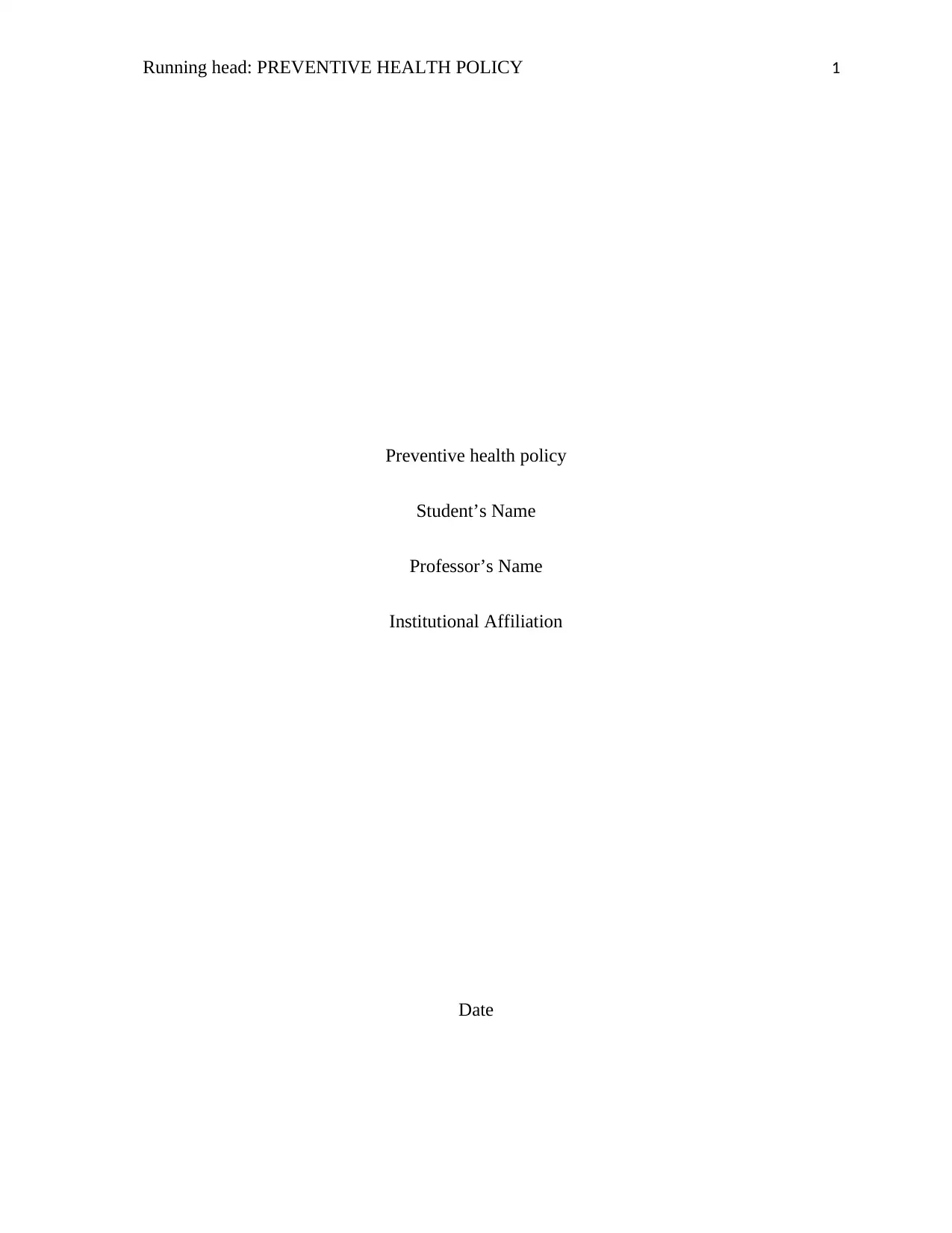
Running head: PREVENTIVE HEALTH POLICY 1
Preventive health policy
Student’s Name
Professor’s Name
Institutional Affiliation
Date
Preventive health policy
Student’s Name
Professor’s Name
Institutional Affiliation
Date
Paraphrase This Document
Need a fresh take? Get an instant paraphrase of this document with our AI Paraphraser
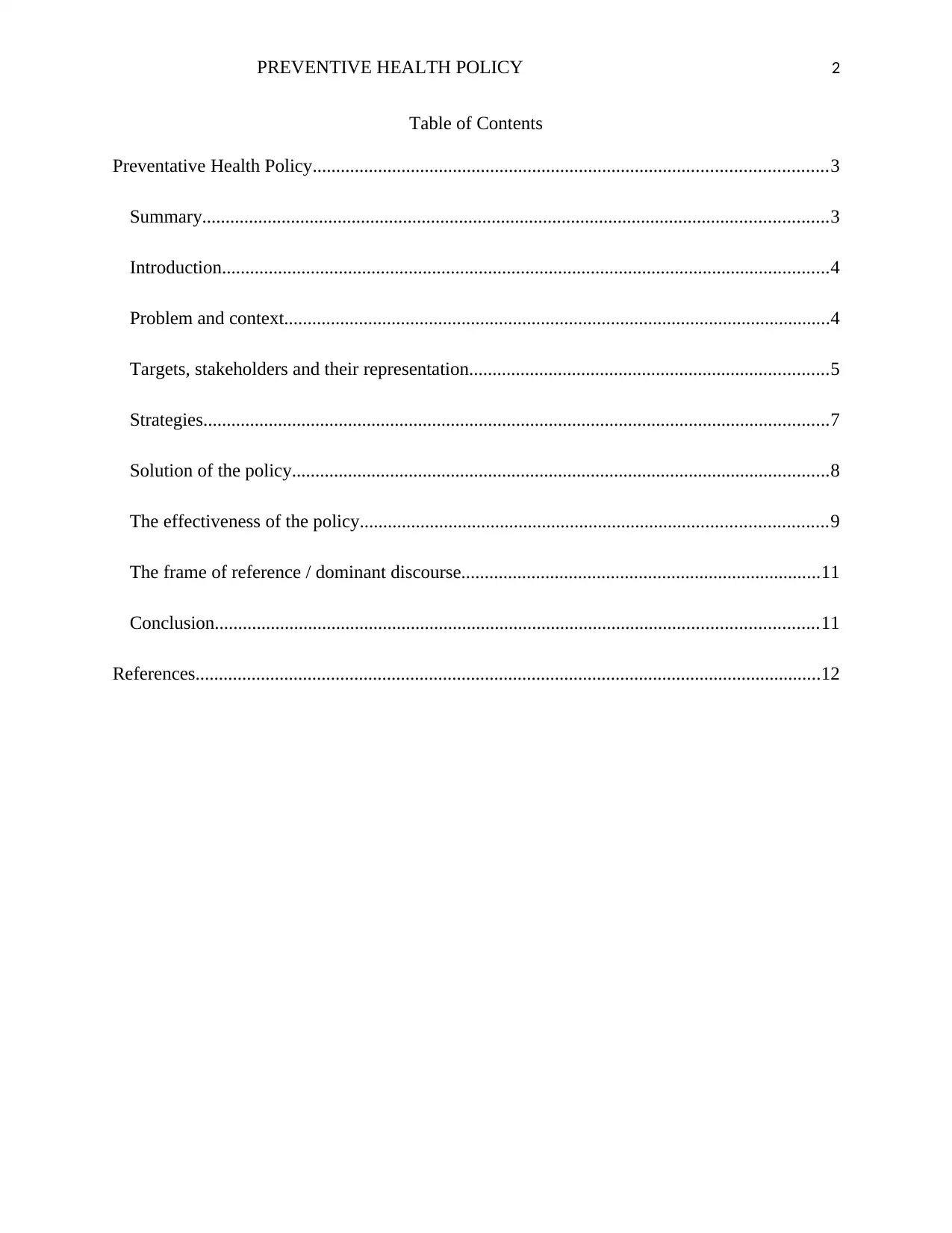
PREVENTIVE HEALTH POLICY 2
Table of Contents
Preventative Health Policy..............................................................................................................3
Summary......................................................................................................................................3
Introduction..................................................................................................................................4
Problem and context.....................................................................................................................4
Targets, stakeholders and their representation.............................................................................5
Strategies......................................................................................................................................7
Solution of the policy...................................................................................................................8
The effectiveness of the policy....................................................................................................9
The frame of reference / dominant discourse.............................................................................11
Conclusion.................................................................................................................................11
References......................................................................................................................................12
Table of Contents
Preventative Health Policy..............................................................................................................3
Summary......................................................................................................................................3
Introduction..................................................................................................................................4
Problem and context.....................................................................................................................4
Targets, stakeholders and their representation.............................................................................5
Strategies......................................................................................................................................7
Solution of the policy...................................................................................................................8
The effectiveness of the policy....................................................................................................9
The frame of reference / dominant discourse.............................................................................11
Conclusion.................................................................................................................................11
References......................................................................................................................................12
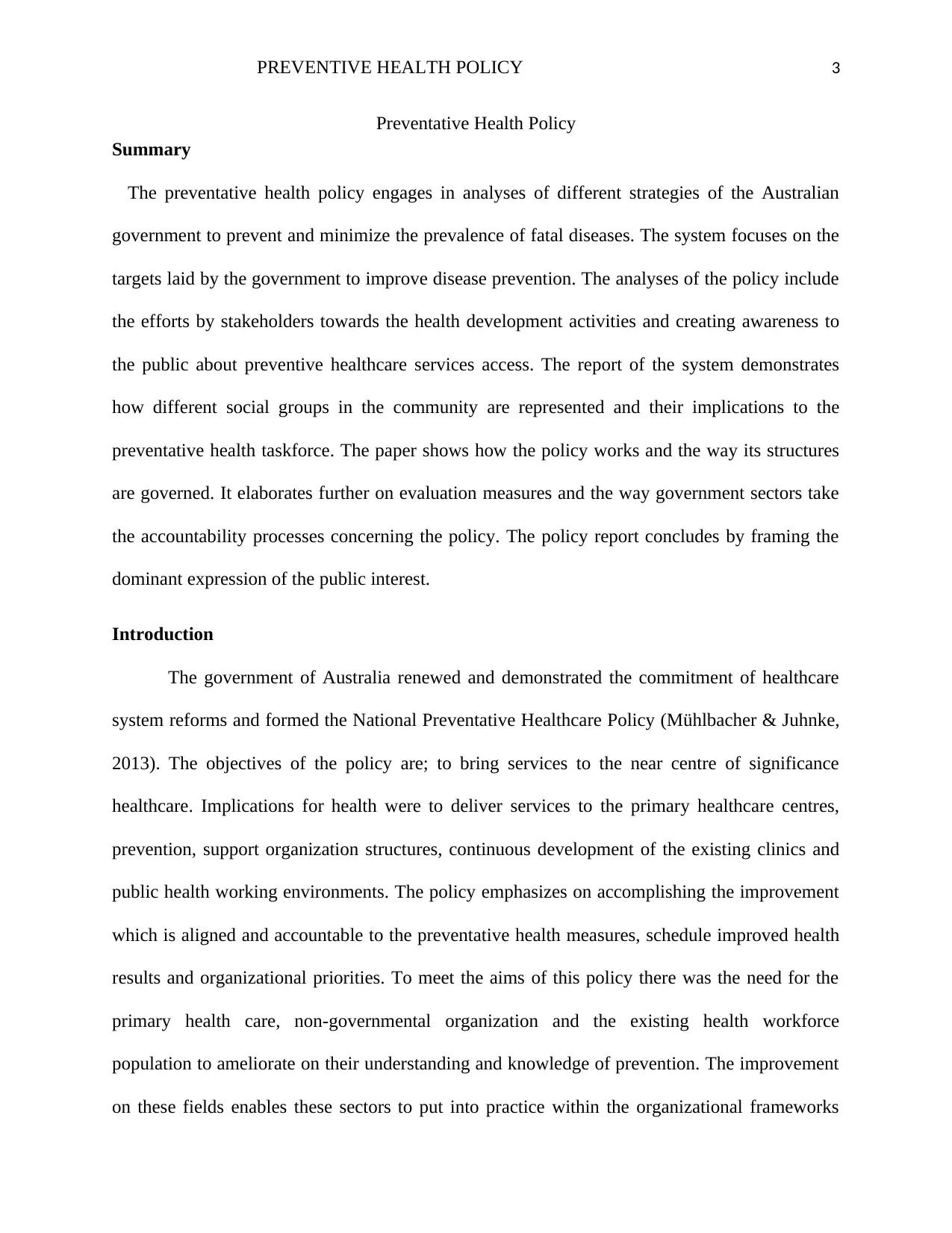
PREVENTIVE HEALTH POLICY 3
Preventative Health Policy
Summary
The preventative health policy engages in analyses of different strategies of the Australian
government to prevent and minimize the prevalence of fatal diseases. The system focuses on the
targets laid by the government to improve disease prevention. The analyses of the policy include
the efforts by stakeholders towards the health development activities and creating awareness to
the public about preventive healthcare services access. The report of the system demonstrates
how different social groups in the community are represented and their implications to the
preventative health taskforce. The paper shows how the policy works and the way its structures
are governed. It elaborates further on evaluation measures and the way government sectors take
the accountability processes concerning the policy. The policy report concludes by framing the
dominant expression of the public interest.
Introduction
The government of Australia renewed and demonstrated the commitment of healthcare
system reforms and formed the National Preventative Healthcare Policy (Mühlbacher & Juhnke,
2013). The objectives of the policy are; to bring services to the near centre of significance
healthcare. Implications for health were to deliver services to the primary healthcare centres,
prevention, support organization structures, continuous development of the existing clinics and
public health working environments. The policy emphasizes on accomplishing the improvement
which is aligned and accountable to the preventative health measures, schedule improved health
results and organizational priorities. To meet the aims of this policy there was the need for the
primary health care, non-governmental organization and the existing health workforce
population to ameliorate on their understanding and knowledge of prevention. The improvement
on these fields enables these sectors to put into practice within the organizational frameworks
Preventative Health Policy
Summary
The preventative health policy engages in analyses of different strategies of the Australian
government to prevent and minimize the prevalence of fatal diseases. The system focuses on the
targets laid by the government to improve disease prevention. The analyses of the policy include
the efforts by stakeholders towards the health development activities and creating awareness to
the public about preventive healthcare services access. The report of the system demonstrates
how different social groups in the community are represented and their implications to the
preventative health taskforce. The paper shows how the policy works and the way its structures
are governed. It elaborates further on evaluation measures and the way government sectors take
the accountability processes concerning the policy. The policy report concludes by framing the
dominant expression of the public interest.
Introduction
The government of Australia renewed and demonstrated the commitment of healthcare
system reforms and formed the National Preventative Healthcare Policy (Mühlbacher & Juhnke,
2013). The objectives of the policy are; to bring services to the near centre of significance
healthcare. Implications for health were to deliver services to the primary healthcare centres,
prevention, support organization structures, continuous development of the existing clinics and
public health working environments. The policy emphasizes on accomplishing the improvement
which is aligned and accountable to the preventative health measures, schedule improved health
results and organizational priorities. To meet the aims of this policy there was the need for the
primary health care, non-governmental organization and the existing health workforce
population to ameliorate on their understanding and knowledge of prevention. The improvement
on these fields enables these sectors to put into practice within the organizational frameworks
⊘ This is a preview!⊘
Do you want full access?
Subscribe today to unlock all pages.

Trusted by 1+ million students worldwide
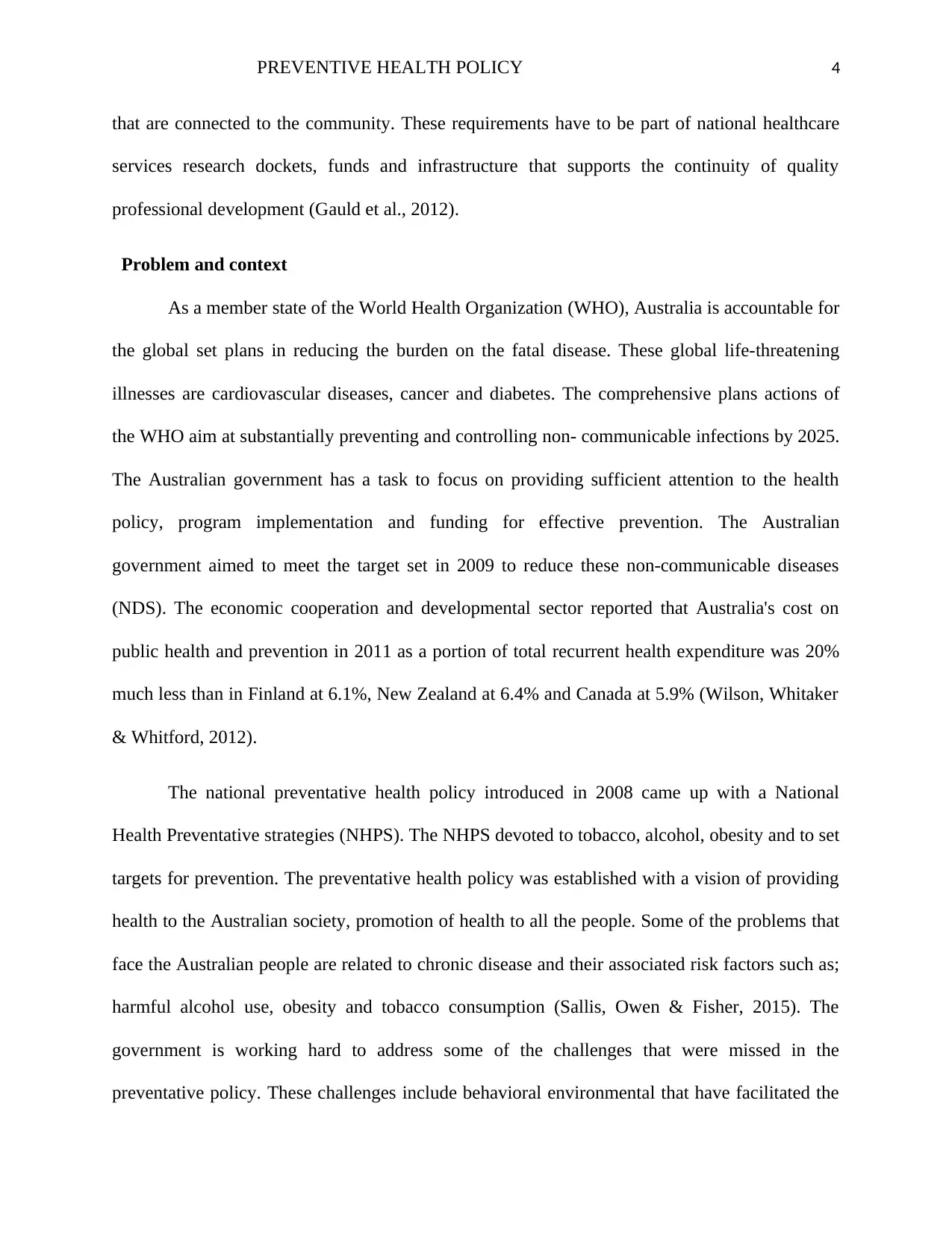
PREVENTIVE HEALTH POLICY 4
that are connected to the community. These requirements have to be part of national healthcare
services research dockets, funds and infrastructure that supports the continuity of quality
professional development (Gauld et al., 2012).
Problem and context
As a member state of the World Health Organization (WHO), Australia is accountable for
the global set plans in reducing the burden on the fatal disease. These global life-threatening
illnesses are cardiovascular diseases, cancer and diabetes. The comprehensive plans actions of
the WHO aim at substantially preventing and controlling non- communicable infections by 2025.
The Australian government has a task to focus on providing sufficient attention to the health
policy, program implementation and funding for effective prevention. The Australian
government aimed to meet the target set in 2009 to reduce these non-communicable diseases
(NDS). The economic cooperation and developmental sector reported that Australia's cost on
public health and prevention in 2011 as a portion of total recurrent health expenditure was 20%
much less than in Finland at 6.1%, New Zealand at 6.4% and Canada at 5.9% (Wilson, Whitaker
& Whitford, 2012).
The national preventative health policy introduced in 2008 came up with a National
Health Preventative strategies (NHPS). The NHPS devoted to tobacco, alcohol, obesity and to set
targets for prevention. The preventative health policy was established with a vision of providing
health to the Australian society, promotion of health to all the people. Some of the problems that
face the Australian people are related to chronic disease and their associated risk factors such as;
harmful alcohol use, obesity and tobacco consumption (Sallis, Owen & Fisher, 2015). The
government is working hard to address some of the challenges that were missed in the
preventative policy. These challenges include behavioral environmental that have facilitated the
that are connected to the community. These requirements have to be part of national healthcare
services research dockets, funds and infrastructure that supports the continuity of quality
professional development (Gauld et al., 2012).
Problem and context
As a member state of the World Health Organization (WHO), Australia is accountable for
the global set plans in reducing the burden on the fatal disease. These global life-threatening
illnesses are cardiovascular diseases, cancer and diabetes. The comprehensive plans actions of
the WHO aim at substantially preventing and controlling non- communicable infections by 2025.
The Australian government has a task to focus on providing sufficient attention to the health
policy, program implementation and funding for effective prevention. The Australian
government aimed to meet the target set in 2009 to reduce these non-communicable diseases
(NDS). The economic cooperation and developmental sector reported that Australia's cost on
public health and prevention in 2011 as a portion of total recurrent health expenditure was 20%
much less than in Finland at 6.1%, New Zealand at 6.4% and Canada at 5.9% (Wilson, Whitaker
& Whitford, 2012).
The national preventative health policy introduced in 2008 came up with a National
Health Preventative strategies (NHPS). The NHPS devoted to tobacco, alcohol, obesity and to set
targets for prevention. The preventative health policy was established with a vision of providing
health to the Australian society, promotion of health to all the people. Some of the problems that
face the Australian people are related to chronic disease and their associated risk factors such as;
harmful alcohol use, obesity and tobacco consumption (Sallis, Owen & Fisher, 2015). The
government is working hard to address some of the challenges that were missed in the
preventative policy. These challenges include behavioral environmental that have facilitated the
Paraphrase This Document
Need a fresh take? Get an instant paraphrase of this document with our AI Paraphraser
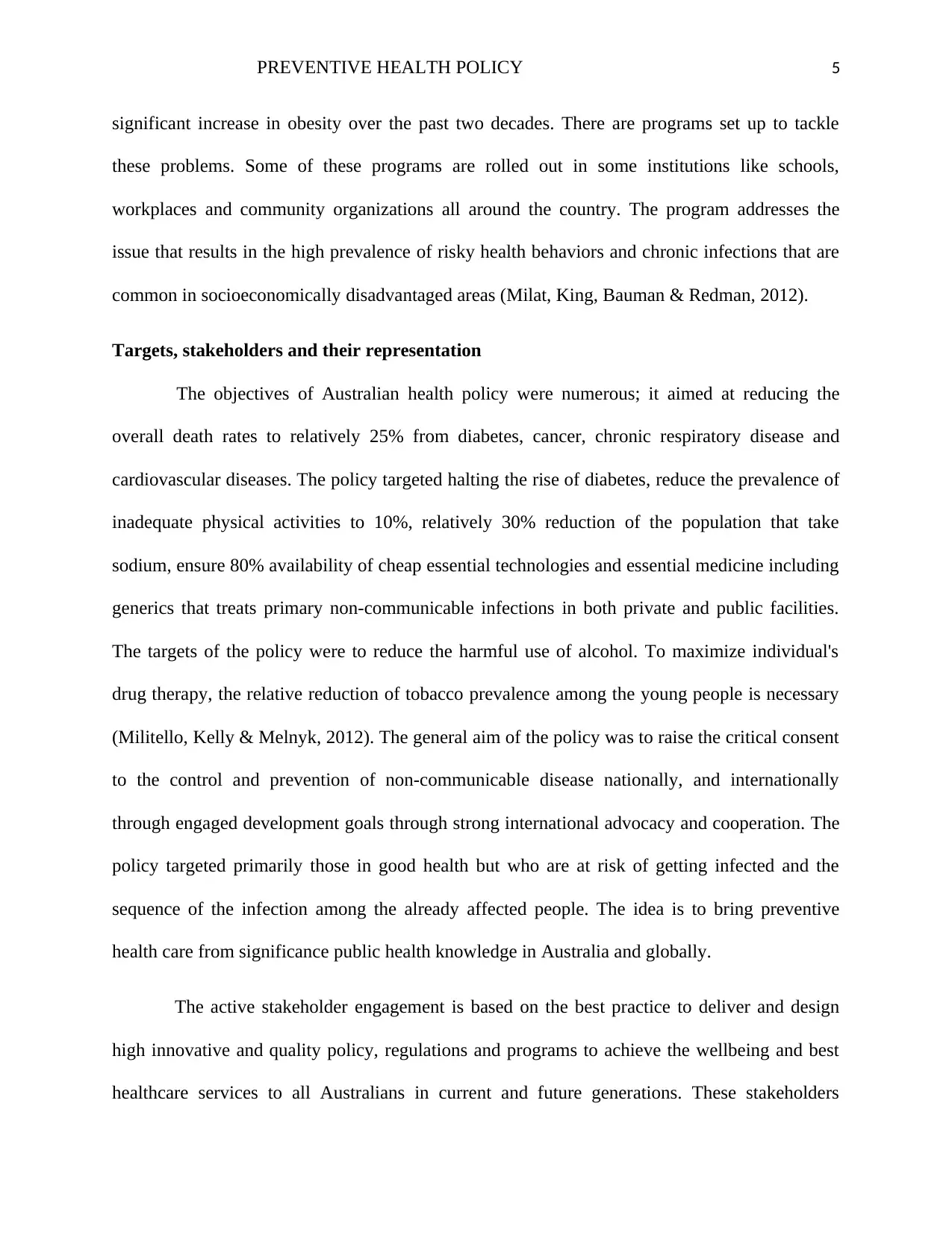
PREVENTIVE HEALTH POLICY 5
significant increase in obesity over the past two decades. There are programs set up to tackle
these problems. Some of these programs are rolled out in some institutions like schools,
workplaces and community organizations all around the country. The program addresses the
issue that results in the high prevalence of risky health behaviors and chronic infections that are
common in socioeconomically disadvantaged areas (Milat, King, Bauman & Redman, 2012).
Targets, stakeholders and their representation
The objectives of Australian health policy were numerous; it aimed at reducing the
overall death rates to relatively 25% from diabetes, cancer, chronic respiratory disease and
cardiovascular diseases. The policy targeted halting the rise of diabetes, reduce the prevalence of
inadequate physical activities to 10%, relatively 30% reduction of the population that take
sodium, ensure 80% availability of cheap essential technologies and essential medicine including
generics that treats primary non-communicable infections in both private and public facilities.
The targets of the policy were to reduce the harmful use of alcohol. To maximize individual's
drug therapy, the relative reduction of tobacco prevalence among the young people is necessary
(Militello, Kelly & Melnyk, 2012). The general aim of the policy was to raise the critical consent
to the control and prevention of non-communicable disease nationally, and internationally
through engaged development goals through strong international advocacy and cooperation. The
policy targeted primarily those in good health but who are at risk of getting infected and the
sequence of the infection among the already affected people. The idea is to bring preventive
health care from significance public health knowledge in Australia and globally.
The active stakeholder engagement is based on the best practice to deliver and design
high innovative and quality policy, regulations and programs to achieve the wellbeing and best
healthcare services to all Australians in current and future generations. These stakeholders
significant increase in obesity over the past two decades. There are programs set up to tackle
these problems. Some of these programs are rolled out in some institutions like schools,
workplaces and community organizations all around the country. The program addresses the
issue that results in the high prevalence of risky health behaviors and chronic infections that are
common in socioeconomically disadvantaged areas (Milat, King, Bauman & Redman, 2012).
Targets, stakeholders and their representation
The objectives of Australian health policy were numerous; it aimed at reducing the
overall death rates to relatively 25% from diabetes, cancer, chronic respiratory disease and
cardiovascular diseases. The policy targeted halting the rise of diabetes, reduce the prevalence of
inadequate physical activities to 10%, relatively 30% reduction of the population that take
sodium, ensure 80% availability of cheap essential technologies and essential medicine including
generics that treats primary non-communicable infections in both private and public facilities.
The targets of the policy were to reduce the harmful use of alcohol. To maximize individual's
drug therapy, the relative reduction of tobacco prevalence among the young people is necessary
(Militello, Kelly & Melnyk, 2012). The general aim of the policy was to raise the critical consent
to the control and prevention of non-communicable disease nationally, and internationally
through engaged development goals through strong international advocacy and cooperation. The
policy targeted primarily those in good health but who are at risk of getting infected and the
sequence of the infection among the already affected people. The idea is to bring preventive
health care from significance public health knowledge in Australia and globally.
The active stakeholder engagement is based on the best practice to deliver and design
high innovative and quality policy, regulations and programs to achieve the wellbeing and best
healthcare services to all Australians in current and future generations. These stakeholders
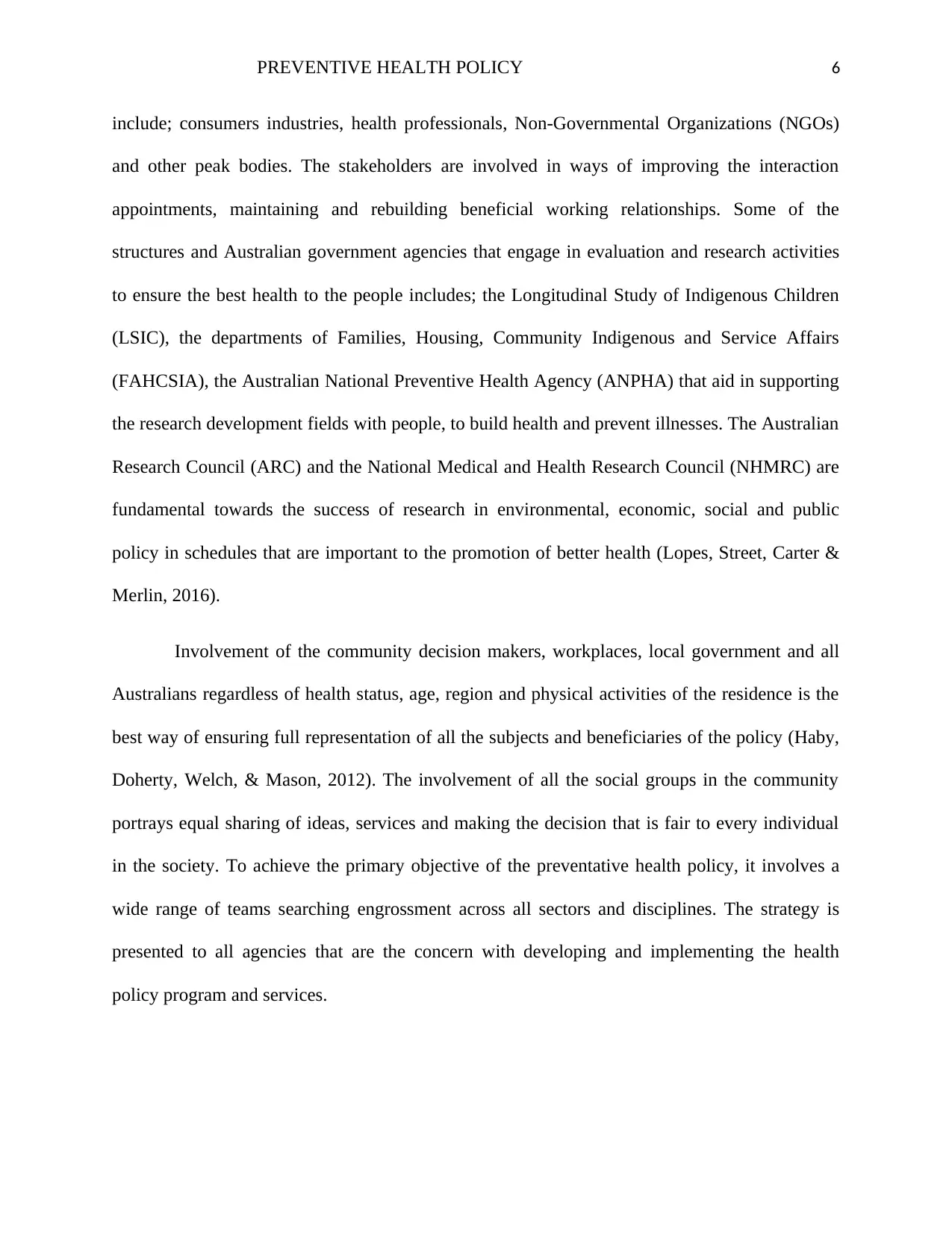
PREVENTIVE HEALTH POLICY 6
include; consumers industries, health professionals, Non-Governmental Organizations (NGOs)
and other peak bodies. The stakeholders are involved in ways of improving the interaction
appointments, maintaining and rebuilding beneficial working relationships. Some of the
structures and Australian government agencies that engage in evaluation and research activities
to ensure the best health to the people includes; the Longitudinal Study of Indigenous Children
(LSIC), the departments of Families, Housing, Community Indigenous and Service Affairs
(FAHCSIA), the Australian National Preventive Health Agency (ANPHA) that aid in supporting
the research development fields with people, to build health and prevent illnesses. The Australian
Research Council (ARC) and the National Medical and Health Research Council (NHMRC) are
fundamental towards the success of research in environmental, economic, social and public
policy in schedules that are important to the promotion of better health (Lopes, Street, Carter &
Merlin, 2016).
Involvement of the community decision makers, workplaces, local government and all
Australians regardless of health status, age, region and physical activities of the residence is the
best way of ensuring full representation of all the subjects and beneficiaries of the policy (Haby,
Doherty, Welch, & Mason, 2012). The involvement of all the social groups in the community
portrays equal sharing of ideas, services and making the decision that is fair to every individual
in the society. To achieve the primary objective of the preventative health policy, it involves a
wide range of teams searching engrossment across all sectors and disciplines. The strategy is
presented to all agencies that are the concern with developing and implementing the health
policy program and services.
include; consumers industries, health professionals, Non-Governmental Organizations (NGOs)
and other peak bodies. The stakeholders are involved in ways of improving the interaction
appointments, maintaining and rebuilding beneficial working relationships. Some of the
structures and Australian government agencies that engage in evaluation and research activities
to ensure the best health to the people includes; the Longitudinal Study of Indigenous Children
(LSIC), the departments of Families, Housing, Community Indigenous and Service Affairs
(FAHCSIA), the Australian National Preventive Health Agency (ANPHA) that aid in supporting
the research development fields with people, to build health and prevent illnesses. The Australian
Research Council (ARC) and the National Medical and Health Research Council (NHMRC) are
fundamental towards the success of research in environmental, economic, social and public
policy in schedules that are important to the promotion of better health (Lopes, Street, Carter &
Merlin, 2016).
Involvement of the community decision makers, workplaces, local government and all
Australians regardless of health status, age, region and physical activities of the residence is the
best way of ensuring full representation of all the subjects and beneficiaries of the policy (Haby,
Doherty, Welch, & Mason, 2012). The involvement of all the social groups in the community
portrays equal sharing of ideas, services and making the decision that is fair to every individual
in the society. To achieve the primary objective of the preventative health policy, it involves a
wide range of teams searching engrossment across all sectors and disciplines. The strategy is
presented to all agencies that are the concern with developing and implementing the health
policy program and services.
⊘ This is a preview!⊘
Do you want full access?
Subscribe today to unlock all pages.

Trusted by 1+ million students worldwide
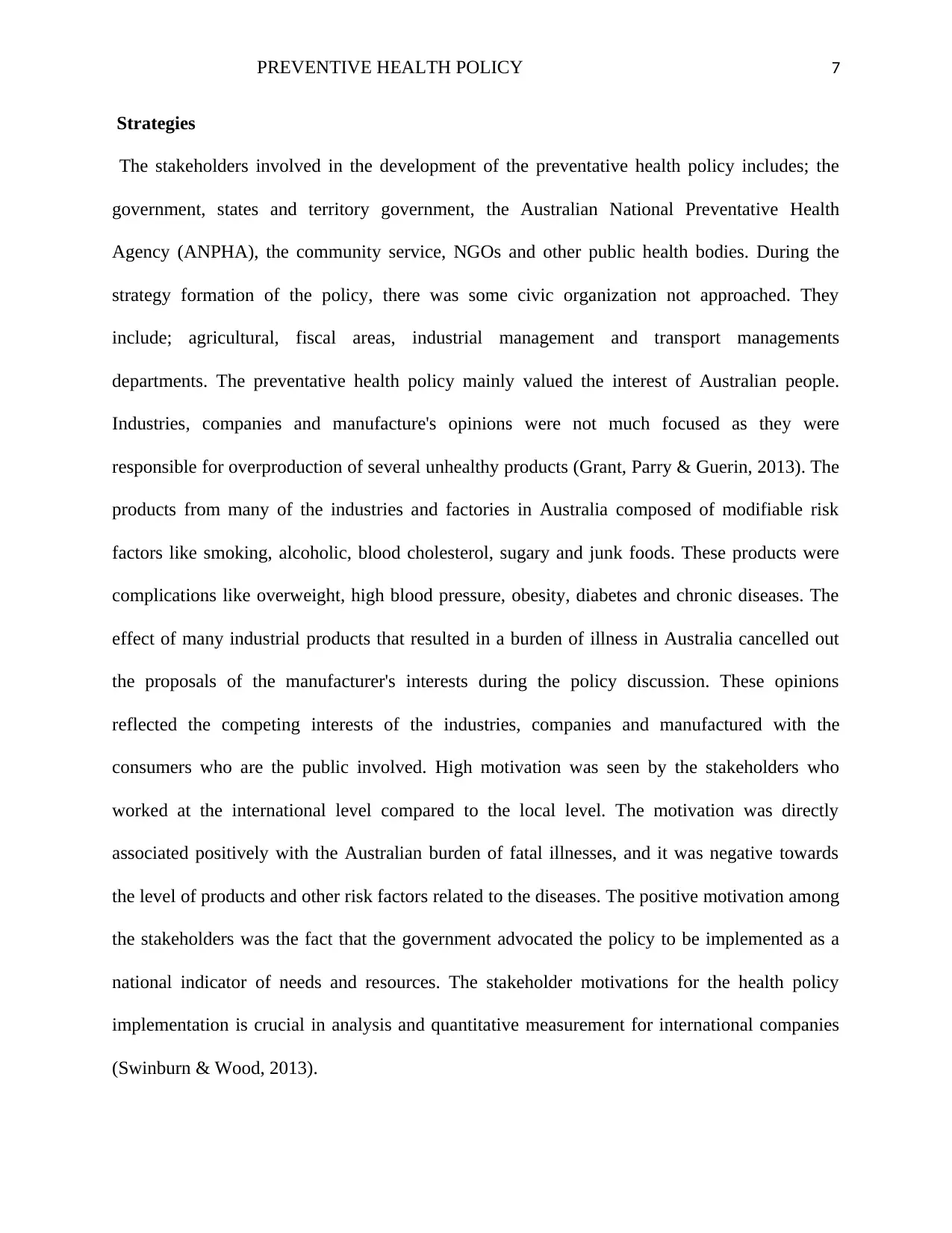
PREVENTIVE HEALTH POLICY 7
Strategies
The stakeholders involved in the development of the preventative health policy includes; the
government, states and territory government, the Australian National Preventative Health
Agency (ANPHA), the community service, NGOs and other public health bodies. During the
strategy formation of the policy, there was some civic organization not approached. They
include; agricultural, fiscal areas, industrial management and transport managements
departments. The preventative health policy mainly valued the interest of Australian people.
Industries, companies and manufacture's opinions were not much focused as they were
responsible for overproduction of several unhealthy products (Grant, Parry & Guerin, 2013). The
products from many of the industries and factories in Australia composed of modifiable risk
factors like smoking, alcoholic, blood cholesterol, sugary and junk foods. These products were
complications like overweight, high blood pressure, obesity, diabetes and chronic diseases. The
effect of many industrial products that resulted in a burden of illness in Australia cancelled out
the proposals of the manufacturer's interests during the policy discussion. These opinions
reflected the competing interests of the industries, companies and manufactured with the
consumers who are the public involved. High motivation was seen by the stakeholders who
worked at the international level compared to the local level. The motivation was directly
associated positively with the Australian burden of fatal illnesses, and it was negative towards
the level of products and other risk factors related to the diseases. The positive motivation among
the stakeholders was the fact that the government advocated the policy to be implemented as a
national indicator of needs and resources. The stakeholder motivations for the health policy
implementation is crucial in analysis and quantitative measurement for international companies
(Swinburn & Wood, 2013).
Strategies
The stakeholders involved in the development of the preventative health policy includes; the
government, states and territory government, the Australian National Preventative Health
Agency (ANPHA), the community service, NGOs and other public health bodies. During the
strategy formation of the policy, there was some civic organization not approached. They
include; agricultural, fiscal areas, industrial management and transport managements
departments. The preventative health policy mainly valued the interest of Australian people.
Industries, companies and manufacture's opinions were not much focused as they were
responsible for overproduction of several unhealthy products (Grant, Parry & Guerin, 2013). The
products from many of the industries and factories in Australia composed of modifiable risk
factors like smoking, alcoholic, blood cholesterol, sugary and junk foods. These products were
complications like overweight, high blood pressure, obesity, diabetes and chronic diseases. The
effect of many industrial products that resulted in a burden of illness in Australia cancelled out
the proposals of the manufacturer's interests during the policy discussion. These opinions
reflected the competing interests of the industries, companies and manufactured with the
consumers who are the public involved. High motivation was seen by the stakeholders who
worked at the international level compared to the local level. The motivation was directly
associated positively with the Australian burden of fatal illnesses, and it was negative towards
the level of products and other risk factors related to the diseases. The positive motivation among
the stakeholders was the fact that the government advocated the policy to be implemented as a
national indicator of needs and resources. The stakeholder motivations for the health policy
implementation is crucial in analysis and quantitative measurement for international companies
(Swinburn & Wood, 2013).
Paraphrase This Document
Need a fresh take? Get an instant paraphrase of this document with our AI Paraphraser
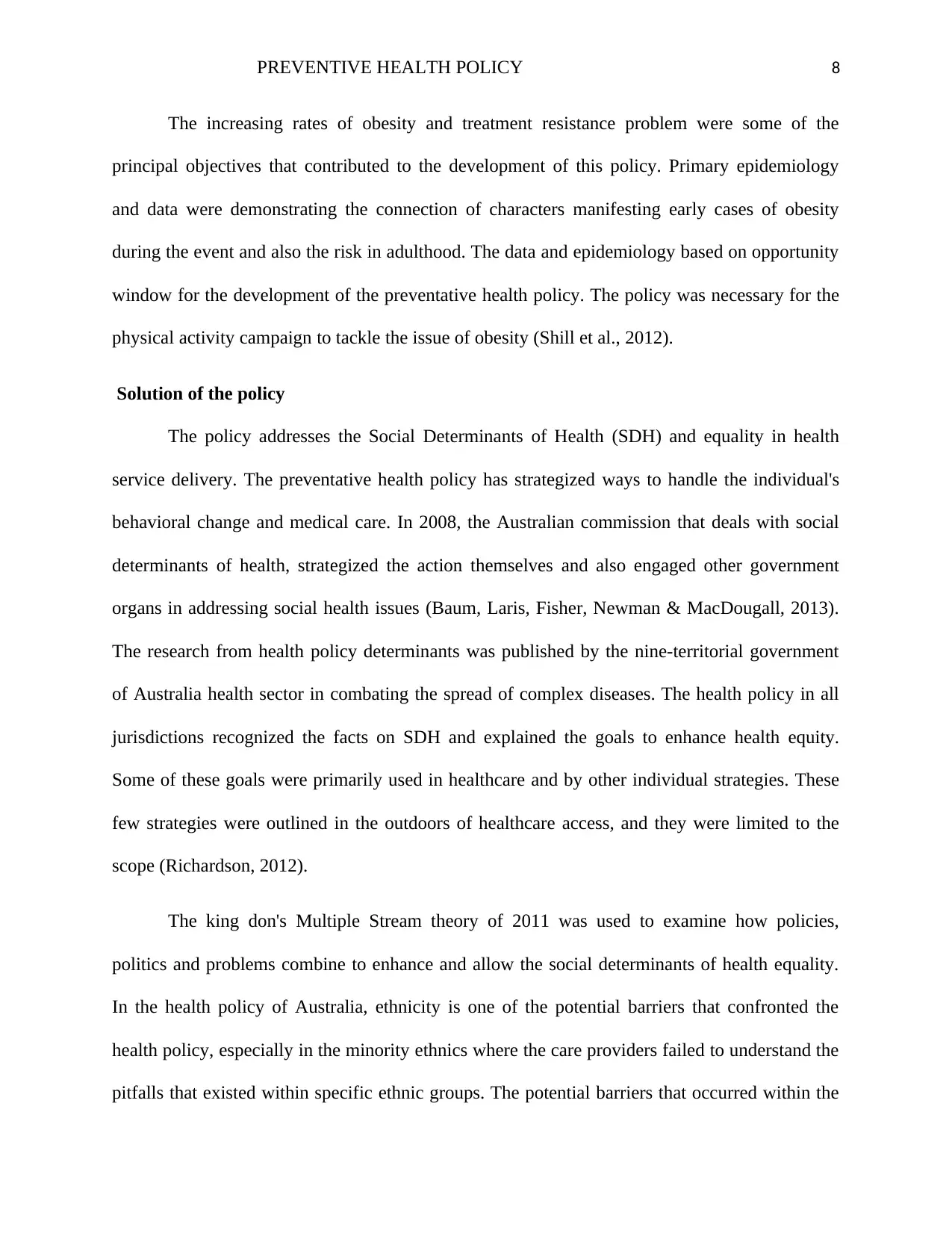
PREVENTIVE HEALTH POLICY 8
The increasing rates of obesity and treatment resistance problem were some of the
principal objectives that contributed to the development of this policy. Primary epidemiology
and data were demonstrating the connection of characters manifesting early cases of obesity
during the event and also the risk in adulthood. The data and epidemiology based on opportunity
window for the development of the preventative health policy. The policy was necessary for the
physical activity campaign to tackle the issue of obesity (Shill et al., 2012).
Solution of the policy
The policy addresses the Social Determinants of Health (SDH) and equality in health
service delivery. The preventative health policy has strategized ways to handle the individual's
behavioral change and medical care. In 2008, the Australian commission that deals with social
determinants of health, strategized the action themselves and also engaged other government
organs in addressing social health issues (Baum, Laris, Fisher, Newman & MacDougall, 2013).
The research from health policy determinants was published by the nine-territorial government
of Australia health sector in combating the spread of complex diseases. The health policy in all
jurisdictions recognized the facts on SDH and explained the goals to enhance health equity.
Some of these goals were primarily used in healthcare and by other individual strategies. These
few strategies were outlined in the outdoors of healthcare access, and they were limited to the
scope (Richardson, 2012).
The king don's Multiple Stream theory of 2011 was used to examine how policies,
politics and problems combine to enhance and allow the social determinants of health equality.
In the health policy of Australia, ethnicity is one of the potential barriers that confronted the
health policy, especially in the minority ethnics where the care providers failed to understand the
pitfalls that existed within specific ethnic groups. The potential barriers that occurred within the
The increasing rates of obesity and treatment resistance problem were some of the
principal objectives that contributed to the development of this policy. Primary epidemiology
and data were demonstrating the connection of characters manifesting early cases of obesity
during the event and also the risk in adulthood. The data and epidemiology based on opportunity
window for the development of the preventative health policy. The policy was necessary for the
physical activity campaign to tackle the issue of obesity (Shill et al., 2012).
Solution of the policy
The policy addresses the Social Determinants of Health (SDH) and equality in health
service delivery. The preventative health policy has strategized ways to handle the individual's
behavioral change and medical care. In 2008, the Australian commission that deals with social
determinants of health, strategized the action themselves and also engaged other government
organs in addressing social health issues (Baum, Laris, Fisher, Newman & MacDougall, 2013).
The research from health policy determinants was published by the nine-territorial government
of Australia health sector in combating the spread of complex diseases. The health policy in all
jurisdictions recognized the facts on SDH and explained the goals to enhance health equity.
Some of these goals were primarily used in healthcare and by other individual strategies. These
few strategies were outlined in the outdoors of healthcare access, and they were limited to the
scope (Richardson, 2012).
The king don's Multiple Stream theory of 2011 was used to examine how policies,
politics and problems combine to enhance and allow the social determinants of health equality.
In the health policy of Australia, ethnicity is one of the potential barriers that confronted the
health policy, especially in the minority ethnics where the care providers failed to understand the
pitfalls that existed within specific ethnic groups. The potential barriers that occurred within the
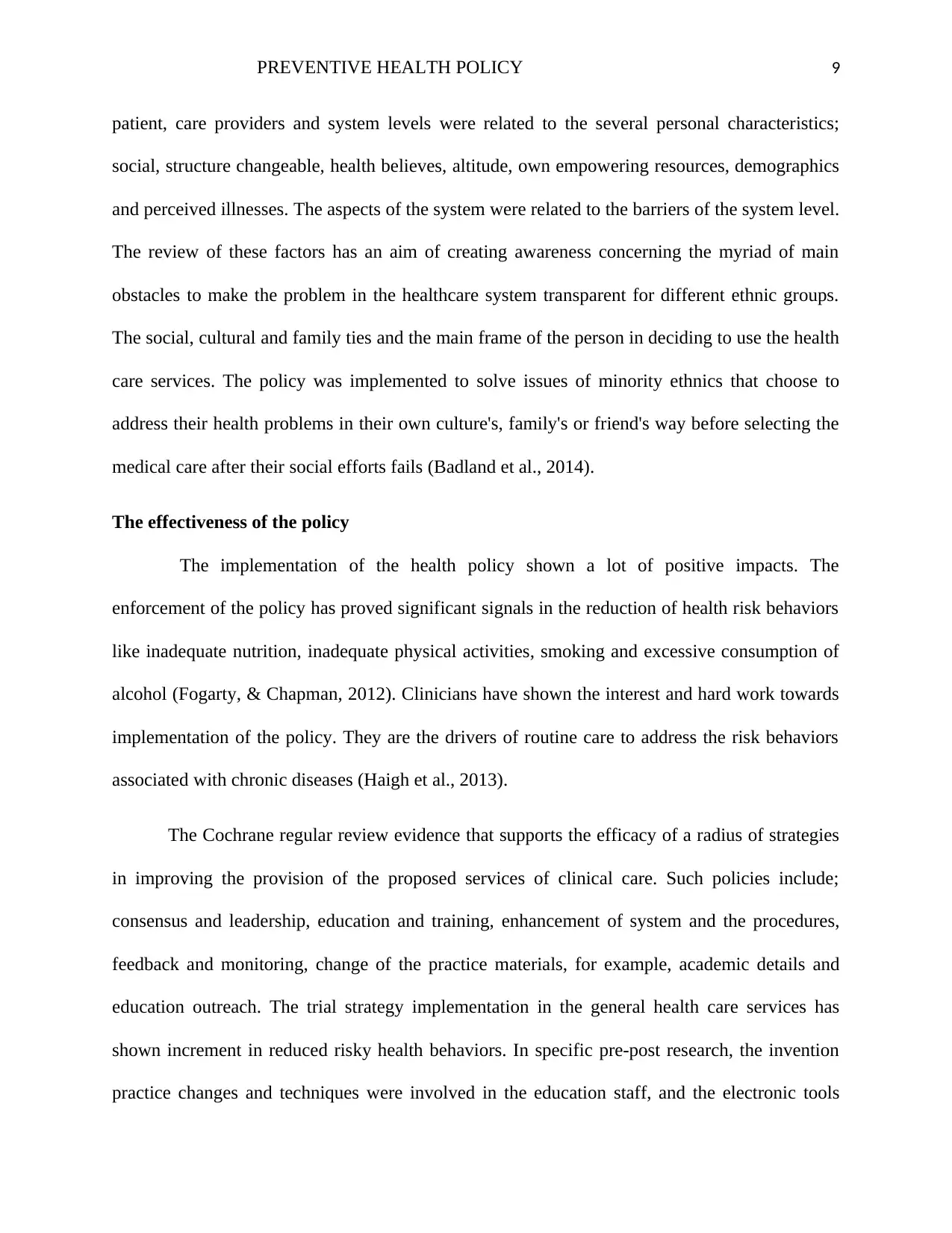
PREVENTIVE HEALTH POLICY 9
patient, care providers and system levels were related to the several personal characteristics;
social, structure changeable, health believes, altitude, own empowering resources, demographics
and perceived illnesses. The aspects of the system were related to the barriers of the system level.
The review of these factors has an aim of creating awareness concerning the myriad of main
obstacles to make the problem in the healthcare system transparent for different ethnic groups.
The social, cultural and family ties and the main frame of the person in deciding to use the health
care services. The policy was implemented to solve issues of minority ethnics that choose to
address their health problems in their own culture's, family's or friend's way before selecting the
medical care after their social efforts fails (Badland et al., 2014).
The effectiveness of the policy
The implementation of the health policy shown a lot of positive impacts. The
enforcement of the policy has proved significant signals in the reduction of health risk behaviors
like inadequate nutrition, inadequate physical activities, smoking and excessive consumption of
alcohol (Fogarty, & Chapman, 2012). Clinicians have shown the interest and hard work towards
implementation of the policy. They are the drivers of routine care to address the risk behaviors
associated with chronic diseases (Haigh et al., 2013).
The Cochrane regular review evidence that supports the efficacy of a radius of strategies
in improving the provision of the proposed services of clinical care. Such policies include;
consensus and leadership, education and training, enhancement of system and the procedures,
feedback and monitoring, change of the practice materials, for example, academic details and
education outreach. The trial strategy implementation in the general health care services has
shown increment in reduced risky health behaviors. In specific pre-post research, the invention
practice changes and techniques were involved in the education staff, and the electronic tools
patient, care providers and system levels were related to the several personal characteristics;
social, structure changeable, health believes, altitude, own empowering resources, demographics
and perceived illnesses. The aspects of the system were related to the barriers of the system level.
The review of these factors has an aim of creating awareness concerning the myriad of main
obstacles to make the problem in the healthcare system transparent for different ethnic groups.
The social, cultural and family ties and the main frame of the person in deciding to use the health
care services. The policy was implemented to solve issues of minority ethnics that choose to
address their health problems in their own culture's, family's or friend's way before selecting the
medical care after their social efforts fails (Badland et al., 2014).
The effectiveness of the policy
The implementation of the health policy shown a lot of positive impacts. The
enforcement of the policy has proved significant signals in the reduction of health risk behaviors
like inadequate nutrition, inadequate physical activities, smoking and excessive consumption of
alcohol (Fogarty, & Chapman, 2012). Clinicians have shown the interest and hard work towards
implementation of the policy. They are the drivers of routine care to address the risk behaviors
associated with chronic diseases (Haigh et al., 2013).
The Cochrane regular review evidence that supports the efficacy of a radius of strategies
in improving the provision of the proposed services of clinical care. Such policies include;
consensus and leadership, education and training, enhancement of system and the procedures,
feedback and monitoring, change of the practice materials, for example, academic details and
education outreach. The trial strategy implementation in the general health care services has
shown increment in reduced risky health behaviors. In specific pre-post research, the invention
practice changes and techniques were involved in the education staff, and the electronic tools
⊘ This is a preview!⊘
Do you want full access?
Subscribe today to unlock all pages.

Trusted by 1+ million students worldwide
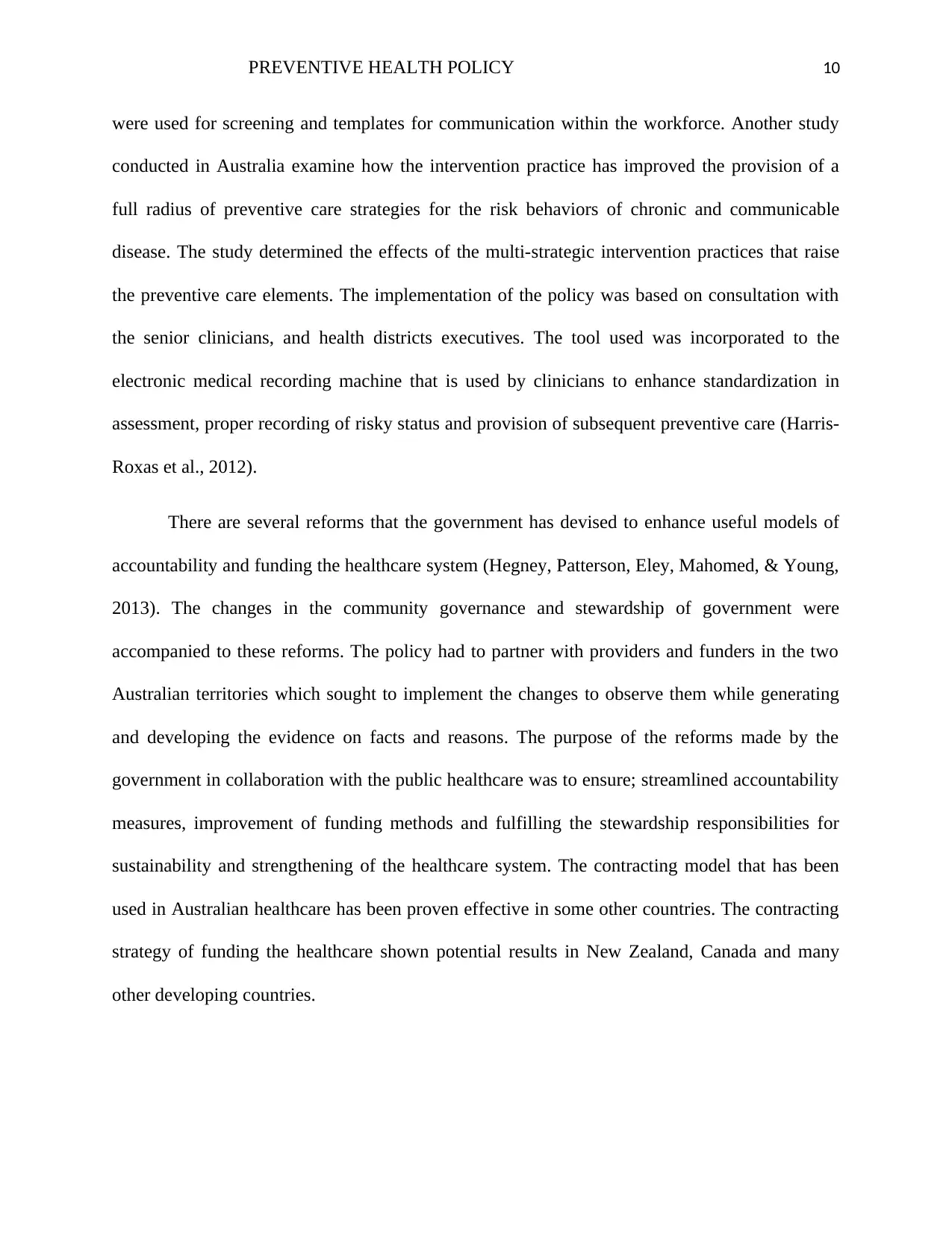
PREVENTIVE HEALTH POLICY 10
were used for screening and templates for communication within the workforce. Another study
conducted in Australia examine how the intervention practice has improved the provision of a
full radius of preventive care strategies for the risk behaviors of chronic and communicable
disease. The study determined the effects of the multi-strategic intervention practices that raise
the preventive care elements. The implementation of the policy was based on consultation with
the senior clinicians, and health districts executives. The tool used was incorporated to the
electronic medical recording machine that is used by clinicians to enhance standardization in
assessment, proper recording of risky status and provision of subsequent preventive care (Harris-
Roxas et al., 2012).
There are several reforms that the government has devised to enhance useful models of
accountability and funding the healthcare system (Hegney, Patterson, Eley, Mahomed, & Young,
2013). The changes in the community governance and stewardship of government were
accompanied to these reforms. The policy had to partner with providers and funders in the two
Australian territories which sought to implement the changes to observe them while generating
and developing the evidence on facts and reasons. The purpose of the reforms made by the
government in collaboration with the public healthcare was to ensure; streamlined accountability
measures, improvement of funding methods and fulfilling the stewardship responsibilities for
sustainability and strengthening of the healthcare system. The contracting model that has been
used in Australian healthcare has been proven effective in some other countries. The contracting
strategy of funding the healthcare shown potential results in New Zealand, Canada and many
other developing countries.
were used for screening and templates for communication within the workforce. Another study
conducted in Australia examine how the intervention practice has improved the provision of a
full radius of preventive care strategies for the risk behaviors of chronic and communicable
disease. The study determined the effects of the multi-strategic intervention practices that raise
the preventive care elements. The implementation of the policy was based on consultation with
the senior clinicians, and health districts executives. The tool used was incorporated to the
electronic medical recording machine that is used by clinicians to enhance standardization in
assessment, proper recording of risky status and provision of subsequent preventive care (Harris-
Roxas et al., 2012).
There are several reforms that the government has devised to enhance useful models of
accountability and funding the healthcare system (Hegney, Patterson, Eley, Mahomed, & Young,
2013). The changes in the community governance and stewardship of government were
accompanied to these reforms. The policy had to partner with providers and funders in the two
Australian territories which sought to implement the changes to observe them while generating
and developing the evidence on facts and reasons. The purpose of the reforms made by the
government in collaboration with the public healthcare was to ensure; streamlined accountability
measures, improvement of funding methods and fulfilling the stewardship responsibilities for
sustainability and strengthening of the healthcare system. The contracting model that has been
used in Australian healthcare has been proven effective in some other countries. The contracting
strategy of funding the healthcare shown potential results in New Zealand, Canada and many
other developing countries.
Paraphrase This Document
Need a fresh take? Get an instant paraphrase of this document with our AI Paraphraser
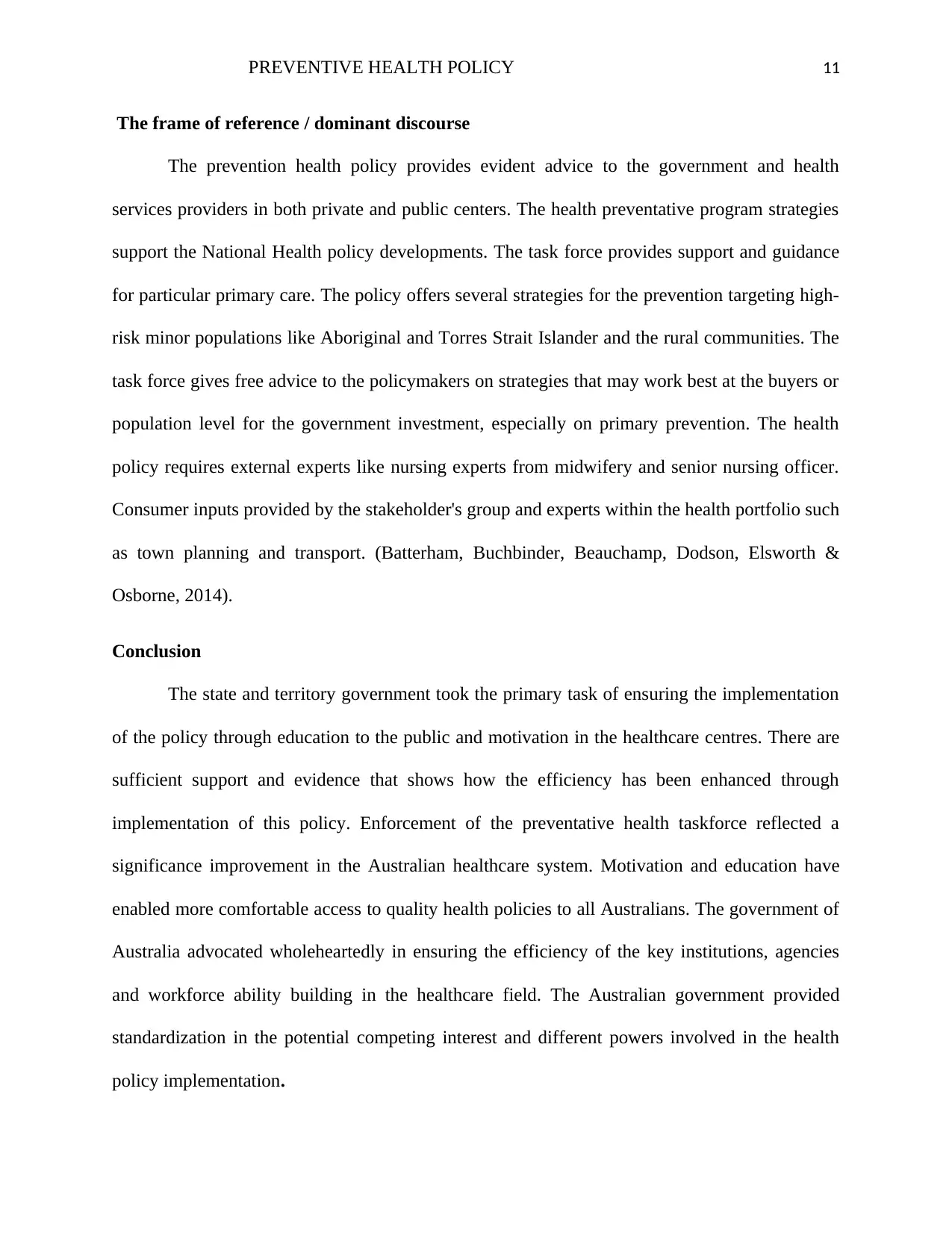
PREVENTIVE HEALTH POLICY 11
The frame of reference / dominant discourse
The prevention health policy provides evident advice to the government and health
services providers in both private and public centers. The health preventative program strategies
support the National Health policy developments. The task force provides support and guidance
for particular primary care. The policy offers several strategies for the prevention targeting high-
risk minor populations like Aboriginal and Torres Strait Islander and the rural communities. The
task force gives free advice to the policymakers on strategies that may work best at the buyers or
population level for the government investment, especially on primary prevention. The health
policy requires external experts like nursing experts from midwifery and senior nursing officer.
Consumer inputs provided by the stakeholder's group and experts within the health portfolio such
as town planning and transport. (Batterham, Buchbinder, Beauchamp, Dodson, Elsworth &
Osborne, 2014).
Conclusion
The state and territory government took the primary task of ensuring the implementation
of the policy through education to the public and motivation in the healthcare centres. There are
sufficient support and evidence that shows how the efficiency has been enhanced through
implementation of this policy. Enforcement of the preventative health taskforce reflected a
significance improvement in the Australian healthcare system. Motivation and education have
enabled more comfortable access to quality health policies to all Australians. The government of
Australia advocated wholeheartedly in ensuring the efficiency of the key institutions, agencies
and workforce ability building in the healthcare field. The Australian government provided
standardization in the potential competing interest and different powers involved in the health
policy implementation.
The frame of reference / dominant discourse
The prevention health policy provides evident advice to the government and health
services providers in both private and public centers. The health preventative program strategies
support the National Health policy developments. The task force provides support and guidance
for particular primary care. The policy offers several strategies for the prevention targeting high-
risk minor populations like Aboriginal and Torres Strait Islander and the rural communities. The
task force gives free advice to the policymakers on strategies that may work best at the buyers or
population level for the government investment, especially on primary prevention. The health
policy requires external experts like nursing experts from midwifery and senior nursing officer.
Consumer inputs provided by the stakeholder's group and experts within the health portfolio such
as town planning and transport. (Batterham, Buchbinder, Beauchamp, Dodson, Elsworth &
Osborne, 2014).
Conclusion
The state and territory government took the primary task of ensuring the implementation
of the policy through education to the public and motivation in the healthcare centres. There are
sufficient support and evidence that shows how the efficiency has been enhanced through
implementation of this policy. Enforcement of the preventative health taskforce reflected a
significance improvement in the Australian healthcare system. Motivation and education have
enabled more comfortable access to quality health policies to all Australians. The government of
Australia advocated wholeheartedly in ensuring the efficiency of the key institutions, agencies
and workforce ability building in the healthcare field. The Australian government provided
standardization in the potential competing interest and different powers involved in the health
policy implementation.
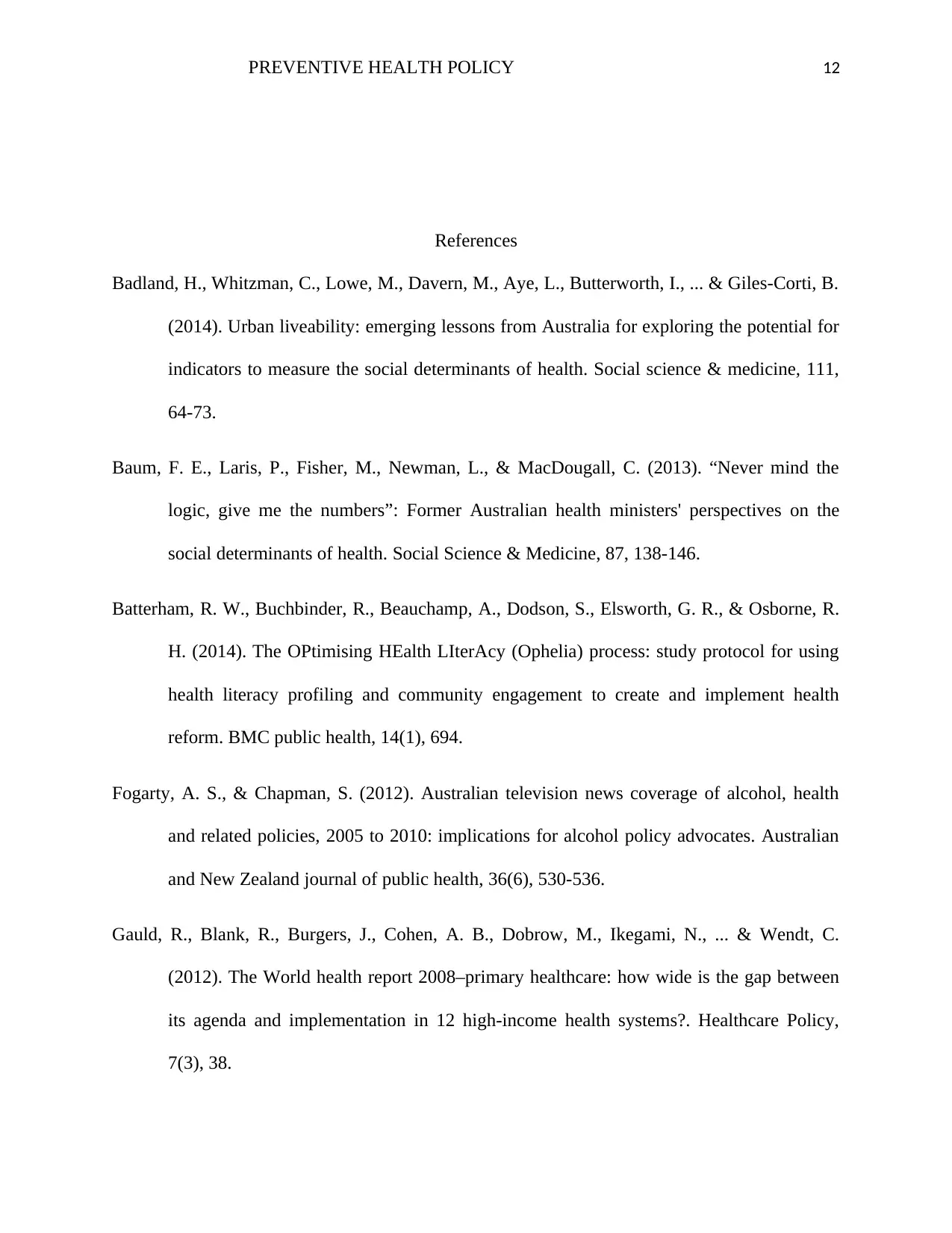
PREVENTIVE HEALTH POLICY 12
References
Badland, H., Whitzman, C., Lowe, M., Davern, M., Aye, L., Butterworth, I., ... & Giles-Corti, B.
(2014). Urban liveability: emerging lessons from Australia for exploring the potential for
indicators to measure the social determinants of health. Social science & medicine, 111,
64-73.
Baum, F. E., Laris, P., Fisher, M., Newman, L., & MacDougall, C. (2013). “Never mind the
logic, give me the numbers”: Former Australian health ministers' perspectives on the
social determinants of health. Social Science & Medicine, 87, 138-146.
Batterham, R. W., Buchbinder, R., Beauchamp, A., Dodson, S., Elsworth, G. R., & Osborne, R.
H. (2014). The OPtimising HEalth LIterAcy (Ophelia) process: study protocol for using
health literacy profiling and community engagement to create and implement health
reform. BMC public health, 14(1), 694.
Fogarty, A. S., & Chapman, S. (2012). Australian television news coverage of alcohol, health
and related policies, 2005 to 2010: implications for alcohol policy advocates. Australian
and New Zealand journal of public health, 36(6), 530-536.
Gauld, R., Blank, R., Burgers, J., Cohen, A. B., Dobrow, M., Ikegami, N., ... & Wendt, C.
(2012). The World health report 2008–primary healthcare: how wide is the gap between
its agenda and implementation in 12 high-income health systems?. Healthcare Policy,
7(3), 38.
References
Badland, H., Whitzman, C., Lowe, M., Davern, M., Aye, L., Butterworth, I., ... & Giles-Corti, B.
(2014). Urban liveability: emerging lessons from Australia for exploring the potential for
indicators to measure the social determinants of health. Social science & medicine, 111,
64-73.
Baum, F. E., Laris, P., Fisher, M., Newman, L., & MacDougall, C. (2013). “Never mind the
logic, give me the numbers”: Former Australian health ministers' perspectives on the
social determinants of health. Social Science & Medicine, 87, 138-146.
Batterham, R. W., Buchbinder, R., Beauchamp, A., Dodson, S., Elsworth, G. R., & Osborne, R.
H. (2014). The OPtimising HEalth LIterAcy (Ophelia) process: study protocol for using
health literacy profiling and community engagement to create and implement health
reform. BMC public health, 14(1), 694.
Fogarty, A. S., & Chapman, S. (2012). Australian television news coverage of alcohol, health
and related policies, 2005 to 2010: implications for alcohol policy advocates. Australian
and New Zealand journal of public health, 36(6), 530-536.
Gauld, R., Blank, R., Burgers, J., Cohen, A. B., Dobrow, M., Ikegami, N., ... & Wendt, C.
(2012). The World health report 2008–primary healthcare: how wide is the gap between
its agenda and implementation in 12 high-income health systems?. Healthcare Policy,
7(3), 38.
⊘ This is a preview!⊘
Do you want full access?
Subscribe today to unlock all pages.

Trusted by 1+ million students worldwide
1 out of 15
Related Documents
Your All-in-One AI-Powered Toolkit for Academic Success.
+13062052269
info@desklib.com
Available 24*7 on WhatsApp / Email
![[object Object]](/_next/static/media/star-bottom.7253800d.svg)
Unlock your academic potential
Copyright © 2020–2025 A2Z Services. All Rights Reserved. Developed and managed by ZUCOL.





